FARGO — About three hours before dawn on Jan. 22, 1995, a telephone call on his landline awakened Fargo Police Detective Larry Lies.
“A phone outage had taken place, affecting a large portion of Moorhead, Minnesota and long-distance calls in northwest Minnesota,” he was told, according to the Fargo Police Department case file obtained by Forum News Service.
ADVERTISEMENT
Lies hurried to the site at the First Avenue North bridge and discovered a manhole cover leading into a cable vault that was partly open. Crawling inside he found seven telephone cables nearly 4 inches thick each, holding 2,700 pairs of wires or 144 fibers "cleanly cut,” according to the Fargo Police Department’s case file.
Sabotage, investigators determined. A police photographer snapped shots of a line of bootprints in the snow headed toward downtown Fargo.
The outage was vast, bringing Fargo’s telecommunications to its knees. More than 20,000 phone lines and security alarms in the Fargo-Moorhead area went down, costing US West Communications more than $1 million to repair and a $91,500 telephone bill, on May 16, 1995.
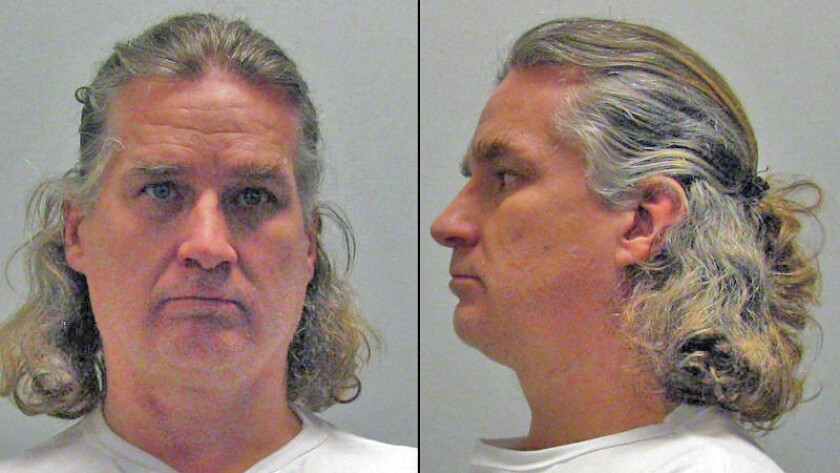
Lies and another detective, Greg Stone, had few clues to work with until they met with Craig Boisjolie, owner of Site on Sound, a Main Street audio and electronic equipment store. He told them his store had been robbed the same night the cables were cut.
The rear garage door was broken into, and the on-site alarm system and a motion detection silent alarm to the Fargo Police Department had also failed. The wiring was cut.
A similar set of bootprints in the snow were also discovered by investigators near Site On Sound, leading them to the railroad where the bootprints ended and a set of snowmobile tracks began. Following the tracks in the snow, police came across an abandoned snowmobile, stolen from Worthington, Minnesota, nine days earlier.
Detectives knew the crimes were connected, but they had no suspect until FBI Agent Wendy Loucks, who was investigating other cases involving the cutting and disabling of US West lines in Cass and Clay counties, told them of a man named Wayne Duane Arvidson. Weeks before the heist, Arvidson, however, had legally changed his name, and Loucks didn’t know what his new name was.
ADVERTISEMENT
The final clue came after investigators met with US West management, who informed them about a customer named Michael Damron, who lived in Fargo, and was attending college at North Dakota State University. He seemed “quite interested in purchasing merchandise from them and seemed to be particularly interested in the same type of property taken in the burglary,” according to the police case file.
The cut wires, the bootprints, the snowmobile and a strange customer painted a picture worthy of a search warrant. On Jan. 24, two days after the reported outage, investigators visited Damron at his Fargo home at 1022 ½ 9th Ave. North, and found bootprints in the snow that were similar to the ones found earlier, according to court documents.
Damron declined a consent request for investigators to search his apartment, but police had enough evidence for a magistrate to issue a search warrant.
Damron, 31, and standing about 6-foot, 5 inches tall, confirmed with police and the FBI that he had changed his name from Arvidson, then left the city while police conducted the search. Damron’s apartment was sparsely furnished with old furniture, a mattress on the floor, a calendar on the wall.
But he had expensive toys: a television with surround sound, a computer, stereo equipment, remote-control boats and more video cameras, as well as five cars, including a white Corvette that he installed a surveillance video camera to monitor, according to The Forum.
He left other conclusive evidence behind, like a map marked with locations of cut and uncut cables, burglary targets — Hobby Hut in Moorhead and a new Best Buy store — as well as a spiral-bound notebook that outlined plans for cutting the cables and getting away. He also left a gas-powered saw covered in copper dust, and much of the stolen goods behind, totaling in value up to $80,000.
Neighbors last saw Damron, the NDSU sophomore, driving away in his car while police searched his house, which was strange because he usually rode a bike to classes, according to The Forum. And then he led police and the FBI on a nationwide manhunt for nearly two years.
ADVERTISEMENT
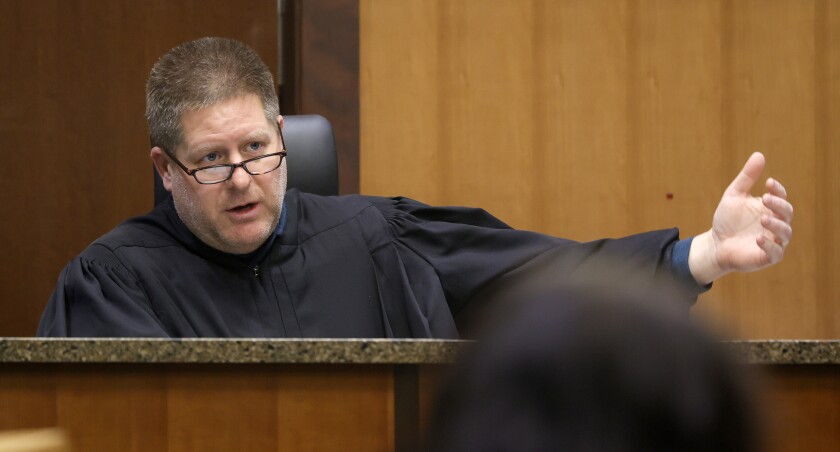
A time before cell towers
Power was returned to the area by Jan. 28, 1995, six days after the wires were cut.
“These crimes were committed in a sophisticated manner and resulted in significant damage. This is a sophisticated property crime and one that I have not seen before or after,” Cass County District Court Judge Wade Webb recently told Forum News Service.
Webb was the prosecuting attorney at the time, which was before cell towers, mobile phones and texts, at least six years before iTunes, a time when one MP3 song could take more than five minutes to download. Fiber optic cables — the height of transmitting data in the 1990s — quickly became the backbone for telecommunication networks, for law enforcement and the public, connecting them for the first time in known history both near and far more cheaply than ever before.
Cutting the wires not only had a “significant impact” on the community, the vandalism came as a shock, Webb said.
“People still talk about it. People say, ’Jeez, you remember that guy who cut off the power?’ They’re still asking about it,” Webb said.
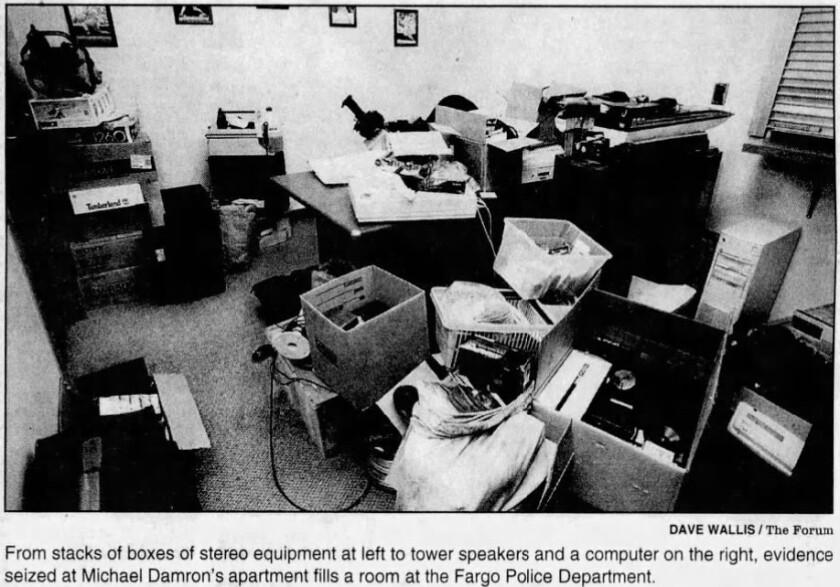
ADVERTISEMENT
‘Quiet technophile’
In 1994, Damron moved to Fargo to pursue a degree in electrical engineering at NDSU. Throughout his criminal career, he targeted mostly entertainment and digital equipment, and on at least two occasions used his own personal surveillance system to watch over his cars or workplaces.
He was called “practically a genius,” a “quiet technophile,” who knew a thing or two about electronics and burglar alarms, according to newspaper reports. A “career criminal,” according to Webb. His criminal history was lengthy as he since a juvenile.
“When he went to engineering school, we thought he’d make something of himself. But (crime) is like a disease with him,” an investigator, who spoke to The Forum on condition he not be identified, said in 1995.
The charges stemming from the Jan. 22 burglary added to a lengthy list of felony convictions for theft, the most spectacular of which involved a shooting and subsequent manhunt through Mississippi bayous, according to The Forum.
And at least one of the previous burglary incidents involved severed telephone lines.
Damron was also connected to a murder plot involving his brother, Wynn Arvidson, after he struck a deal with undercover police officers to kill a man who could implicate them both in a series of burglaries, according to The Forum. Wynn offered to exchange 150 pounds of stolen explosives for $10,000 cash and the death of the would-be informant.
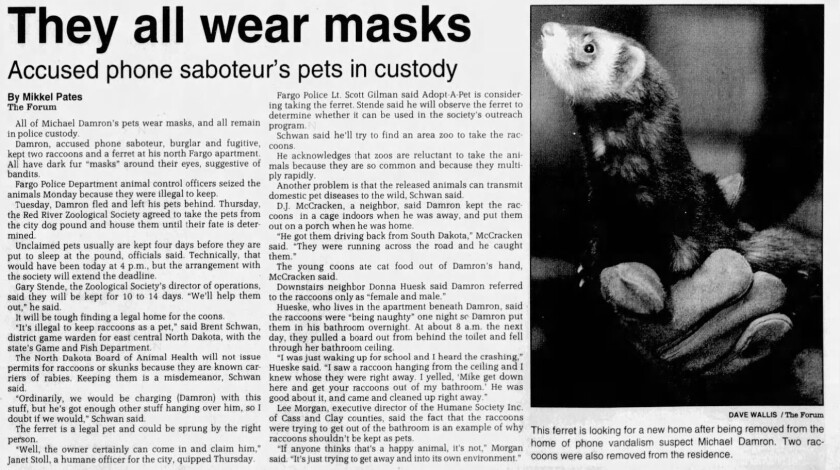
ADVERTISEMENT
Bandit pets
Even Damron’s pets, who all wore masks, were remanded into police custody.
“Damron, accused phone saboteur, burglar and fugitive, kept two raccoons and a ferret at his north Fargo apartment. All have dark fur ‘masks’ around their eyes, suggestive of bandits,” the Forum reported on Jan. 27, 1995.
Police seized the animals because they were illegal to keep and the Red River Zoological Society agreed to take them from the city dog pound.
A neighbor, D.J. McCracken, told The Forum in 19995 that Damron kept the raccoons in a cage indoors, and put them out on a porch when he was home. He fed them cat food by hand.
“He got them driving back from South Dakota. They were running across the road and he caught them,” McCracken told the Forum in 1995.
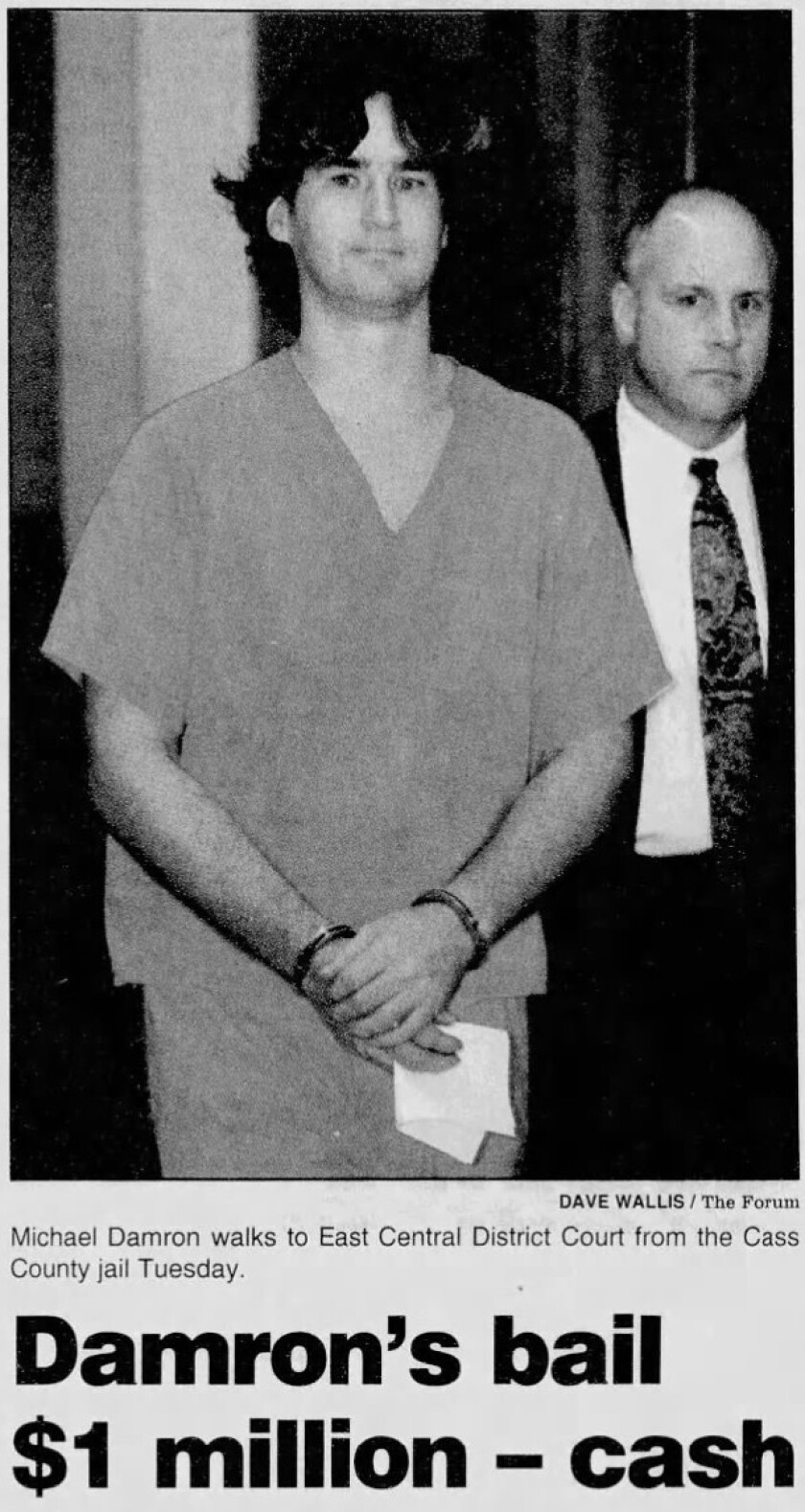
Caught
After finding the evidence inside Damron’s apartment, police charged him with five counts of tampering with or damaging a public service, and burglary, but he had fled the city and eluded capture for nearly two years. While on the run, he used his birthname but was finally picked up by the FBI on Nov. 1, 1996, in Estherville, Iowa.
ADVERTISEMENT
Forum News Service filed an open records request with the FBI, which was denied.
As the prosecuting attorney, Webb did most of the legwork on the case, he told Forum News Service, and to this day has never seen a crime that has affected so many people and businesses.
“It was a significant property crime, on a level that this community had never seen. The investigation and prosecution was thorough and well, as this was an exceptional property crime. We felt that he was a career criminal in that he was doing this on a large scale and we treated it that way,” Webb said.
Damron agreed to plead guilty days before his trial in May 1997, was given a 10-year prison sentence and ordered to pay $250,000 restitution to the phone company.
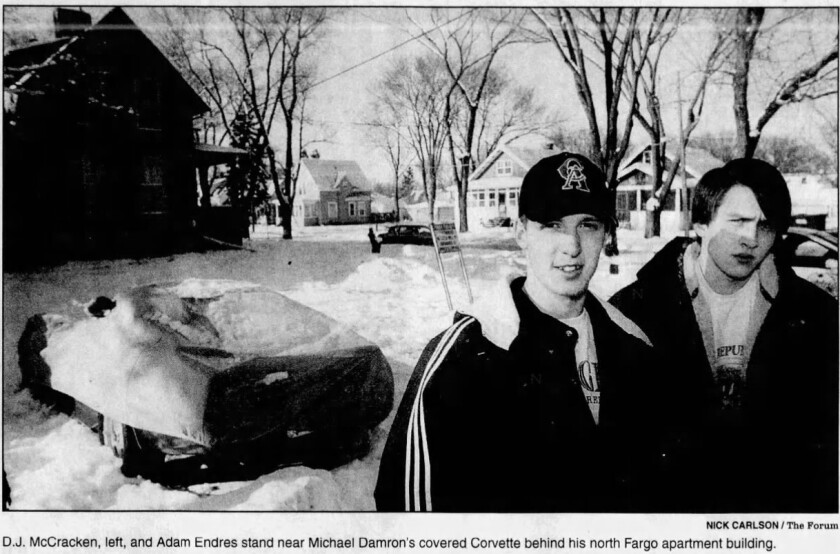
‘One evil act a month’
In 2002, however, Damron changed his tune, saying that his lawyer and family pressured him into taking the plea deal. He appealed his conviction, saying evidence against him wasn’t properly gathered, but his appeal was overturned.
Two years later, he threatened a public official in a letter because he was angry that South Central District Judge Gail Hagerty dismissed a second appeal.
“I will settle this when I get out, my way,” Damron wrote to Hagerty, promising a series of “evil acts,” according to a June 15, 2004 article in The Forum. “The state deserves one evil act a month.”
The threat shook Hagerty up, according to The Forum.
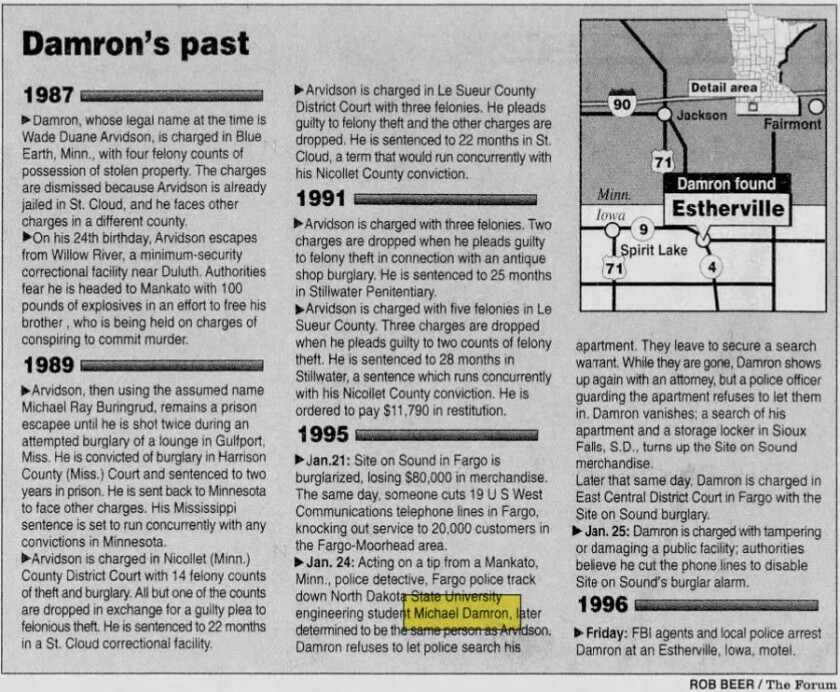
Released and reincarcerated
By the spring of 2005, Damron was released from North Dakota State Penitentiary.
“Few area criminals grabbed the public’s attention like Michael Damron. As a 31-year-old electrical engineering student at North Dakota State University, he sawed through 19 thick underground phone cables the night of Jan. 21, 1995…” Forum reporter Dave Forster wrote about Damron’s pending release.
After his release, Damron did not commit or was not caught for perpetrating one “evil act” every month, but less than two years later he was arrested and convicted for felony theft exceeding $100,000 in stolen property in Dakota County, Minnesota.
Among other crimes, Damron was later sentenced in 2016 to seven years imprisonment for arson in Dakota County after he and his brother tried to burn down the historic Eagan Town Hall, according to a Nov. 2, 2016 article in The Forum.
Some of the evidence used against him were from his own surveillance system, seized by investigators, which recorded them building ignition devices and starting a fire in their driveway just before the town hall fire, according to the criminal complaint.











